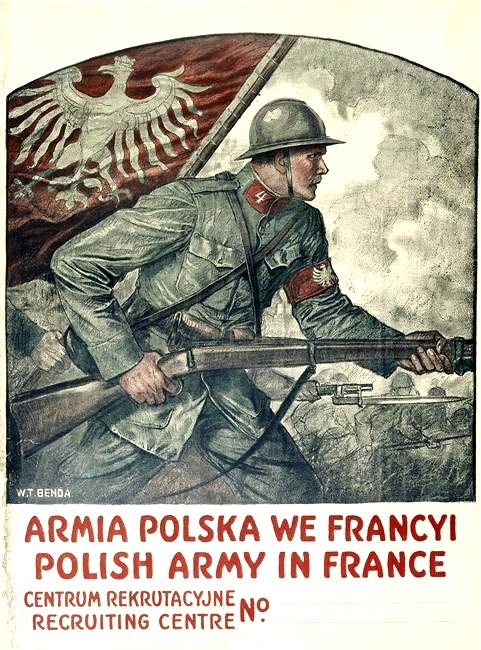How Polish-American Immigrants Helped Turn the Tide of WW1
In 1917, 20,000 Polish-Americans of the “Blue Army” volunteered to fight for Poland’s independence

 World War One was not only the first major global conflict — it was also the first viable opportunity for Poles to finally assert their nationhood and break free of centuries of imperial rule. Aiding in this mission was a large contingent of Polish-American immigrants known as the “Blue Army”.
World War One was not only the first major global conflict — it was also the first viable opportunity for Poles to finally assert their nationhood and break free of centuries of imperial rule. Aiding in this mission was a large contingent of Polish-American immigrants known as the “Blue Army”.
Fighting initially in France and Eastern Europe, these Americans never received the press conferred on the greater American Expeditionary Force. Nonetheless their tale is one of valor, national pride, and bravery.

Founding the Blue Army: A Tale of Two Countries
Before World War I, Poland as a country did not exist. During the 1790s Austria, Prussia, and Russia divided the Polish-Lithuanian Commonwealth up amongst themselves. Under foreign rule, Poland was treated harshly. As a result, many immigrated to America for better opportunities.
Over two million Poles came to the United States — flocking to cities like New York, Detroit, and Chicago for industrial jobs. They embraced democracy and the American way of life, but few forgot how Europe’s empires exploited their motherland.
As World War I continued to escalate into 1917, it became clear Poland had a chance to become independent. Pianist and future statesman Ignacy Paderewski led a recruitment efforts across the U.S., urging immigrants to free their country. Thousands of Polish-Americans volunteered to fight in a Polish unit called the “Blue Army” — named so because of their light blue uniforms. They would prove to be formidable against their enemies.
“The sons of Poland are coming in great numbers from America to fight henceforth under their own colors on the side of the allies in defense of national ideals…The white eagle of Poland may now spread its wings anew and soar in the radiance of victory”.
-French President Raymond Poincaré

The Fight for France
The Blue Army’s first engagement was fighting alongside the French on the Western Front. Their leader, Józef Haller, led a force of 20,000 well-equipped Polish-American fighters to battle against the Germans in Champagne. One engagement was so intense the Blue Army counted thirty-seven bullet holes in their company banner.
When the WWI officially ended in 1918, the Poles’ fight didn’t end — it was only beginning. The infant Polish state was weakened by war and had enemies. To the south, the Ukrainians. To the east, the Soviet Union, intent on annexing the new country. In 1919, both declared war on Poland.

Defending the Homeland: The Polish-Soviet War
The Blue Army first moved to route the Ukrainians in the south. Since their arrival in Eastern Europe, they had grown to 100,000 men with 70 tanks and an air squadron. General Haller sent these forces into Galicia and achieved a quick victory, securing the region for the state.
Fighting the Soviets would be tougher. In 1920, the greater Polish Army was pushed back to Warsaw by a 2-million strong Soviet invasion force. If they managed to cross the Vistula River, all would be lost. Haller’s troops would play a role in this pivotal battle for Poland’s survival.
Surprisingly, the outnumbered Polish and Polish-American troops triumphed. The Soviets broke on the Polish lines, losing 10,000 men. Józef Piłsudski’s army managed to counterattack and run the enemy out of the region. The Blue Army alone captured 14,000 Soviets.
Ultimately, the Battle of Warsaw was called the “Miracle on the Vistula”. A year later, the USSR sued for peace and Poland was finally able to rest.

A Nation Restored
After the fighting ceased, most members of the Blue Army returned to the United States. Around 7,000 stayed in Poland to help build the new country, bringing a uniquely American perspective with them.
Although the First Polish Republic would inevitably succumb to the Nazis in 1939, the heroism of the Blue Army was not in vain. They proved Poles around the world could coalesce to restore their country and create a home for their people.
Main Sources:
Gessner, P. K. (2000). Polish Americans and the Polish Blue Army of World War I. Retrieved August 12, 2020, from http://info-poland.icm.edu.pl/classroom/blue.html
Herek, Raymond J. “Fighting for the Old Country: MICHIGAN’S POLES IN WWI” Michigan History Magazine, vol. 102, no. 4, July-Aug. 2018, p. 24+. Gale Academic OneFile, https://link-gale-com.proxy.lib.umich.edu/apps/doc/A546068260/AONE?u=umuser&sid=AONE&xid=52378a25. Accessed 11 Aug. 2020.
Ruskoski, D. T. (2006). The polish army in france: Immigrants in america, world war I volunteers in france, defenders of the recreated state in poland (Order №3218323). Available from ProQuest Dissertations & Theses Global. (305335697).
